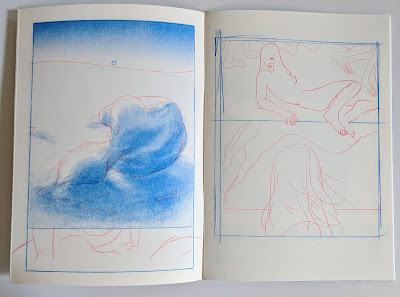Sometimes a work of art hits you in a visceral, aesthetic way upon your first encounter with it. That reaction, though, dissipates slowly as you begin to unpack it by applying logic and reasoning to the experience, and, often, as it is wont to do, your new understanding is less fraught and more manageable.
Yet, in rare occasions, something else happens.
Kindling, the new book by Brooklyn-based artist Xia Gordon (published by 2dCloud), somehow withstands the loss of its initial emotionally-charged power through analysis. In a way, it gains more of an innate, earnest sensibility through the application of head upon heart, upending the duality, and becoming something more.
This is a beautiful book.
The solicitation on the 2dCloud site reads: “Hazy, gesture rich lines explore ideas on love, altruism, and self-sacrifice. Abstract and expressive, visceral and affective, elusive and palpable. A letter to the universe and to oneself: LOVE!” This is the kind of talk that occurs when your language breaks down in order to convey that which you feel the strongest. And yet, what else is there to say?
Gordon’s art is gesticulation, indication. It allows just enough to appeal to the sense-making structures to operate as they do in order to make meaning, but its true impact is in the way it unwraps loose from the page as if almost to caress, to welcome, to enfold. Two-color risographed in a soft red and blue, Kindling at times hearkens to that 3D Anaglyph effect that requires those plastic glasses that you always ending up losing at some point. This adds to the richness and depth of its communication, both upon thinking about and feeling through it.
Kindling tells the story of journey. It tells a story of struggle. Ultimately, though, it tells a story of acceptance: acceptance of the self and acceptance that, even with this, the journey continues. Gordon makes the most of her title for this book. It serves as the building blocks to idea, to self, to community, and to affirmation.
Towards the end of Kindling, Gordon has scratched out a line of text that reads something like (it’s hard to discern through the scribble), “I know you’d feel better(?) if you were here.” and replaces it with “I think you’d like this place.” The simple shift from “I know you’d” to “I think you’d” is all you need to understand what Gordon is after in this book. Reconsidering and choosing not to tell someone the truth of your head, but rather offer them the hope of your heart is the prime mover of Kindling.
It is these small signals that show Gordon is in command of her craft and an artist who has something to share.




No comments:
Post a Comment